Abstract
Proton Hahn spin-echo n.m.r. spectroscopy was employed to detect abnormal metabolites present in rheumatoid synovial fluid that are derived from the deleterious generation of reactive oxygen radical species during exercise of the inflamed rheumatoid joint. A resonance attributable to a low-molecular-mass N-acetylglucosamine-containing oligosaccharide formed by the oxygen-radical-mediated depolymerization of synovial-fluid hyaluronate was clearly demonstrable when subjects with inflammatory joint disease were exercised. Moreover, formate, which may be derived from the attack of OH.radical on synovial-fluid carbohydrates, was also readily detectable in these samples. gamma-Radiolysis of rheumatoid synovial fluid samples and aqueous solutions of hyaluronate also gave rise to the production of the low-molecular-mass hyaluronate-derived oligosaccharide species and markedly elevated concentrations of (non-protein-bound) formate in the biological fluids. As expected, corresponding spectra of gamma-irradiated blood serum samples obtained from normal volunteers did not contain the signal attributable to the low-molecular-mass oligosaccharide species, but the formate resonance (barely detectable in non-irradiated normal serum samples) became clearly visible. Additionally, a curious increase in the effective concentration of non-protein-bound low-molecular-mass metabolites such as acetate, citrate, lactate and glutamine was observed after gamma-radiolysis of all biological fluids studied. The hyaluronate-derived low-molecular-mass oligosaccharide species and formate are suggested as novel markers of reactive oxygen radical activity in the inflamed rheumatoid joint during exercise-induced hypoxic/reperfusion injury.
Full text
PDF
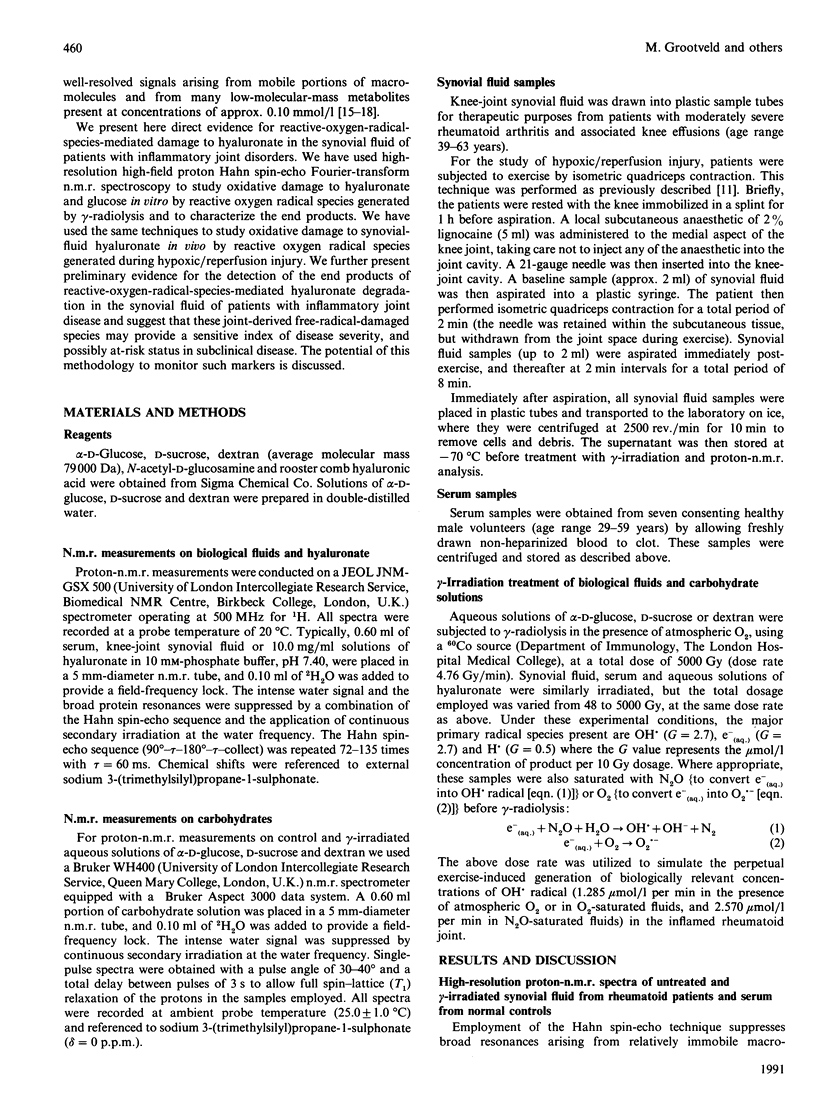



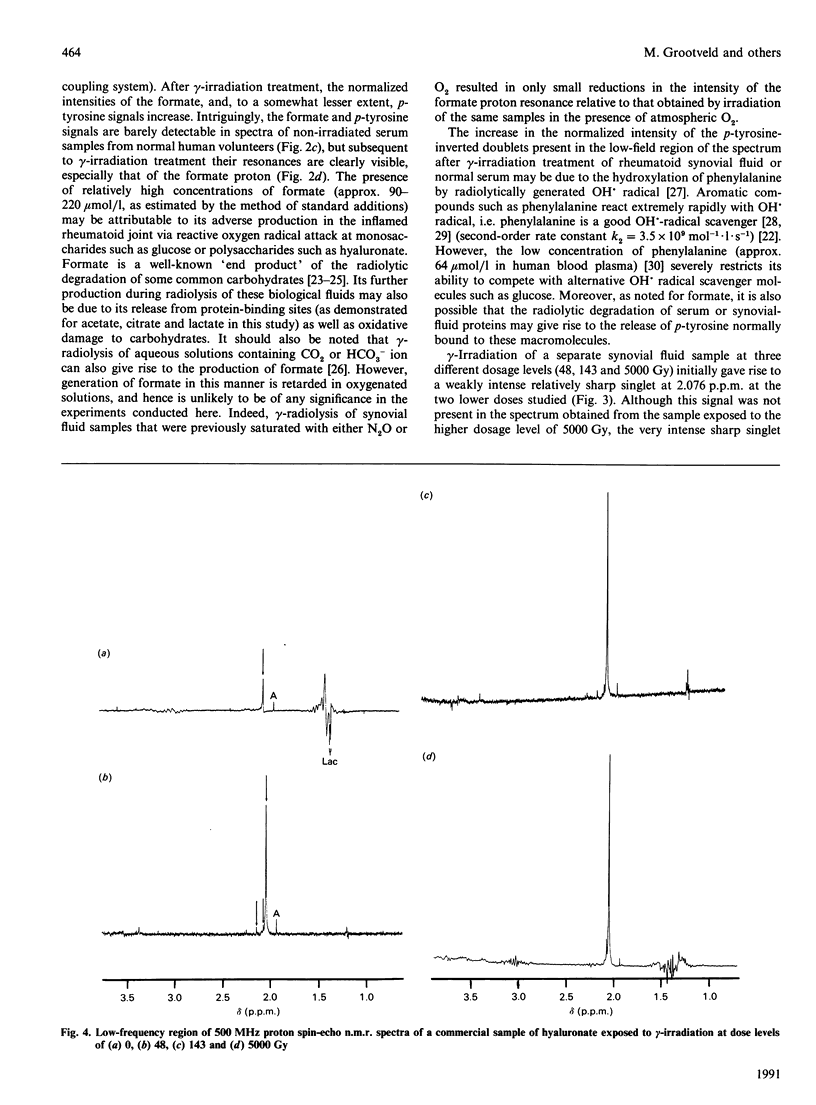
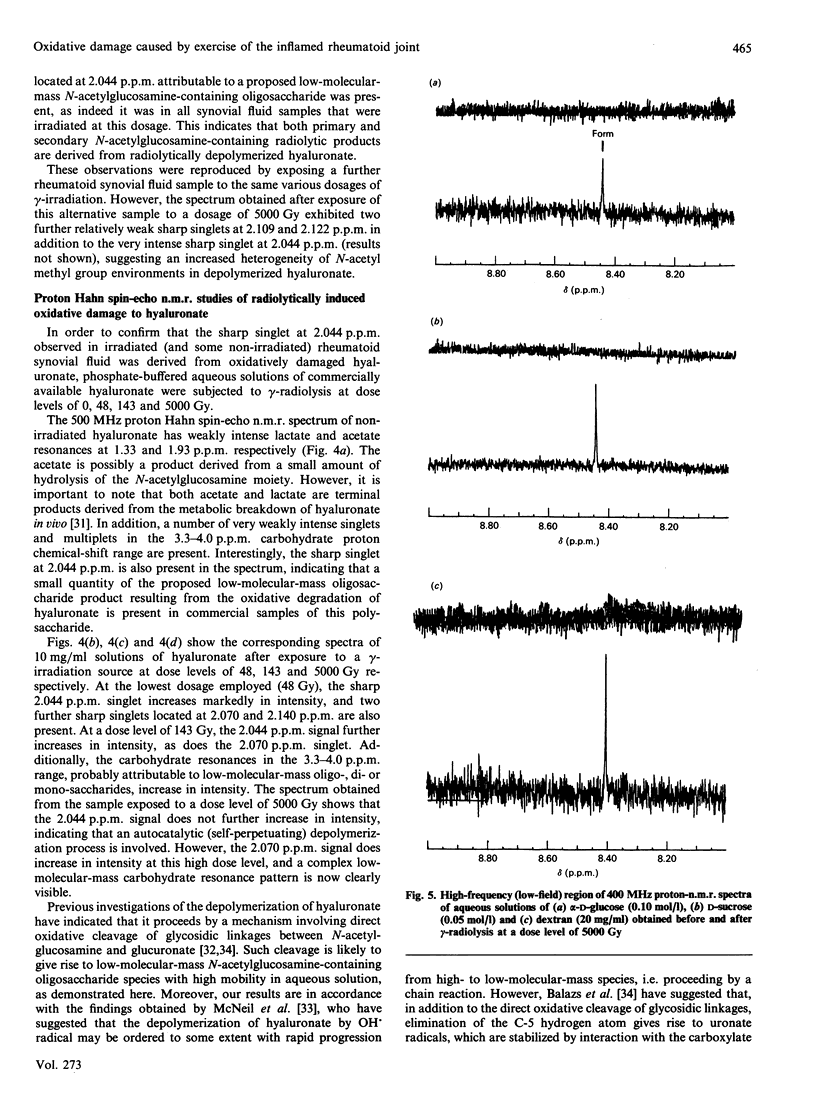
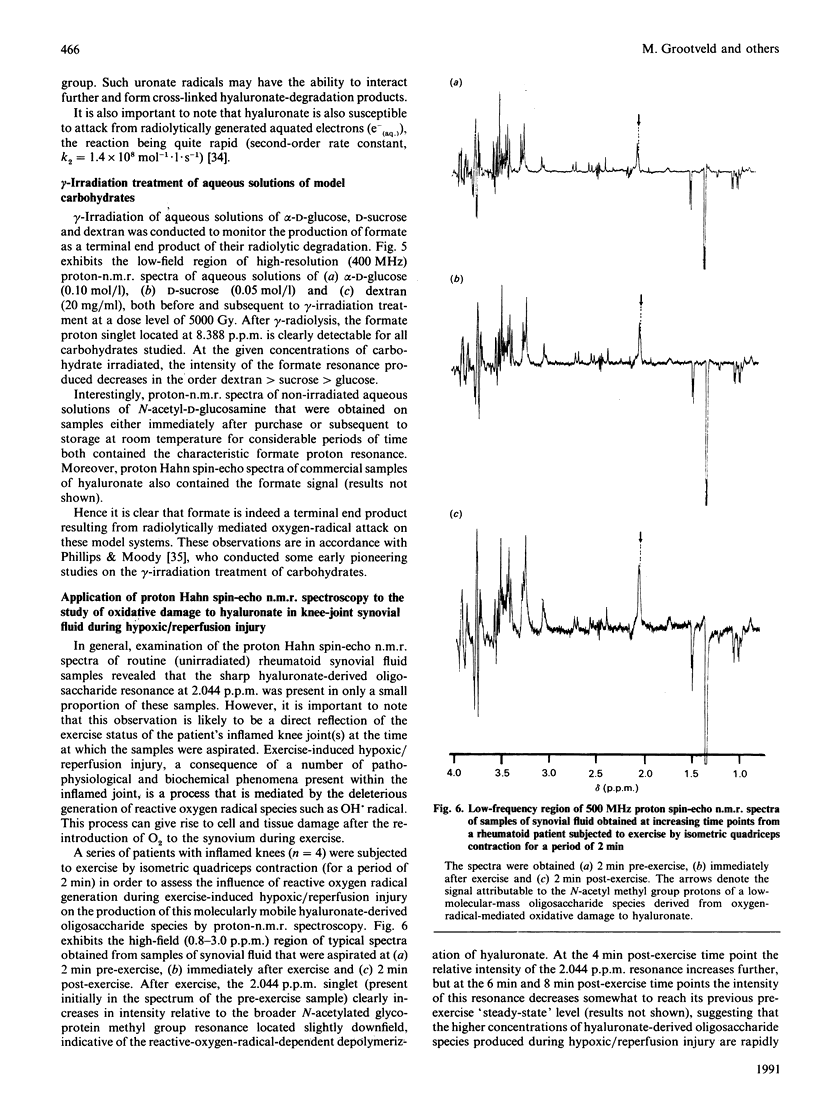
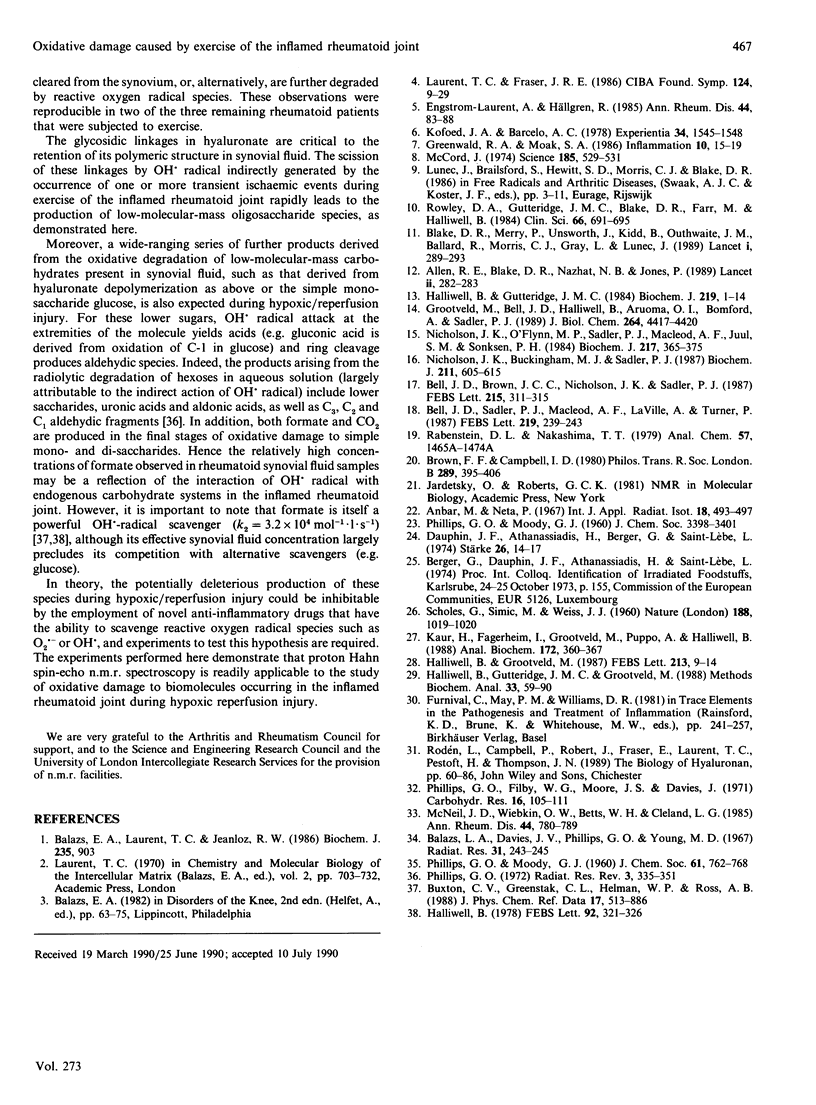
Selected References
These references are in PubMed. This may not be the complete list of references from this article.
- Allen R. E., Blake D. R., Nazhat N. B., Jones P. Superoxide radical generation by inflamed human synovium after hypoxia. Lancet. 1989 Jul 29;2(8657):282–283. doi: 10.1016/s0140-6736(89)90476-5. [DOI] [PubMed] [Google Scholar]
- Balaza E. A., Davies J. V., Phillips G. O., Young M. D. Transient intermediates in the radiolysis of hyaluronic acid. Radiat Res. 1967 Jun;31(2):243–255. [PubMed] [Google Scholar]
- Balazs E. A., Laurent T. C., Jeanloz R. W. Nomenclature of hyaluronic acid. Biochem J. 1986 May 1;235(3):903–903. doi: 10.1042/bj2350903. [DOI] [PMC free article] [PubMed] [Google Scholar]
- Bell J. D., Brown J. C., Nicholson J. K., Sadler P. J. Assignment of resonances for 'acute-phase' glycoproteins in high resolution proton NMR spectra of human blood plasma. FEBS Lett. 1987 May 11;215(2):311–315. doi: 10.1016/0014-5793(87)80168-0. [DOI] [PubMed] [Google Scholar]
- Bell J. D., Sadler P. J., Macleod A. F., Turner P. R., La Ville A. 1H NMR studies of human blood plasma. Assignment of resonances for lipoproteins. FEBS Lett. 1987 Jul 13;219(1):239–243. doi: 10.1016/0014-5793(87)81224-3. [DOI] [PubMed] [Google Scholar]
- Blake D. R., Merry P., Unsworth J., Kidd B. L., Outhwaite J. M., Ballard R., Morris C. J., Gray L., Lunec J. Hypoxic-reperfusion injury in the inflamed human joint. Lancet. 1989 Feb 11;1(8633):289–293. doi: 10.1016/s0140-6736(89)91305-6. [DOI] [PubMed] [Google Scholar]
- Brown F. F., Campbell I. D. N.m.r. studies of red cells. Philos Trans R Soc Lond B Biol Sci. 1980 Jun 25;289(1037):395–406. doi: 10.1098/rstb.1980.0056. [DOI] [PubMed] [Google Scholar]
- Engström-Laurent A., Hällgren R. Circulating hyaluronate in rheumatoid arthritis: relationship to inflammatory activity and the effect of corticosteroid therapy. Ann Rheum Dis. 1985 Feb;44(2):83–88. doi: 10.1136/ard.44.2.83. [DOI] [PMC free article] [PubMed] [Google Scholar]
- Greenwald R. A., Moak S. A. Degradation of hyaluronic acid by polymorphonuclear leukocytes. Inflammation. 1986 Mar;10(1):15–30. doi: 10.1007/BF00916037. [DOI] [PubMed] [Google Scholar]
- Grootveld M., Bell J. D., Halliwell B., Aruoma O. I., Bomford A., Sadler P. J. Non-transferrin-bound iron in plasma or serum from patients with idiopathic hemochromatosis. Characterization by high performance liquid chromatography and nuclear magnetic resonance spectroscopy. J Biol Chem. 1989 Mar 15;264(8):4417–4422. [PubMed] [Google Scholar]
- Halliwell B., Grootveld M., Gutteridge J. M. Methods for the measurement of hydroxyl radicals in biomedical systems: deoxyribose degradation and aromatic hydroxylation. Methods Biochem Anal. 1988;33:59–90. doi: 10.1002/9780470110546.ch2. [DOI] [PubMed] [Google Scholar]
- Halliwell B., Grootveld M. The measurement of free radical reactions in humans. Some thoughts for future experimentation. FEBS Lett. 1987 Mar 9;213(1):9–14. doi: 10.1016/0014-5793(87)81455-2. [DOI] [PubMed] [Google Scholar]
- Halliwell B., Gutteridge J. M. Oxygen toxicity, oxygen radicals, transition metals and disease. Biochem J. 1984 Apr 1;219(1):1–14. doi: 10.1042/bj2190001. [DOI] [PMC free article] [PubMed] [Google Scholar]
- Halliwell B. Superoxide-dependent formation of hydroxyl radicals in the presence of iron chelates: is it a mechanism for hydroxyl radical production in biochemical systems? FEBS Lett. 1978 Aug 15;92(2):321–326. doi: 10.1016/0014-5793(78)80779-0. [DOI] [PubMed] [Google Scholar]
- Kaur H., Fagerheim I., Grootveld M., Puppo A., Halliwell B. Aromatic hydroxylation of phenylalanine as an assay for hydroxyl radicals: application to activated human neutrophils and to the heme protein leghemoglobin. Anal Biochem. 1988 Aug 1;172(2):360–367. doi: 10.1016/0003-2697(88)90456-3. [DOI] [PubMed] [Google Scholar]
- Kofoed J. A., Barceló A. C. The synovial fluid hyaluronic acid in rheumatoid arthritis. Experientia. 1978 Dec 15;34(12):1545–1546. doi: 10.1007/BF02034662. [DOI] [PubMed] [Google Scholar]
- Laurent T. C., Fraser J. R. The properties and turnover of hyaluronan. Ciba Found Symp. 1986;124:9–29. doi: 10.1002/9780470513385.ch2. [DOI] [PubMed] [Google Scholar]
- McCord J. M. Free radicals and inflammation: protection of synovial fluid by superoxide dismutase. Science. 1974 Aug 9;185(4150):529–531. doi: 10.1126/science.185.4150.529. [DOI] [PubMed] [Google Scholar]
- McNeil J. D., Wiebkin O. W., Betts W. H., Cleland L. G. Depolymerisation products of hyaluronic acid after exposure to oxygen-derived free radicals. Ann Rheum Dis. 1985 Nov;44(11):780–789. doi: 10.1136/ard.44.11.780. [DOI] [PMC free article] [PubMed] [Google Scholar]
- Nicholson J. K., Buckingham M. J., Sadler P. J. High resolution 1H n.m.r. studies of vertebrate blood and plasma. Biochem J. 1983 Jun 1;211(3):605–615. doi: 10.1042/bj2110605. [DOI] [PMC free article] [PubMed] [Google Scholar]
- Nicholson J. K., O'Flynn M. P., Sadler P. J., Macleod A. F., Juul S. M., Sönksen P. H. Proton-nuclear-magnetic-resonance studies of serum, plasma and urine from fasting normal and diabetic subjects. Biochem J. 1984 Jan 15;217(2):365–375. doi: 10.1042/bj2170365. [DOI] [PMC free article] [PubMed] [Google Scholar]
- Rowley D., Gutteridge J. M., Blake D., Farr M., Halliwell B. Lipid peroxidation in rheumatoid arthritis: thiobarbituric acid-reactive material and catalytic iron salts in synovial fluid from rheumatoid patients. Clin Sci (Lond) 1984 Jun;66(6):691–695. doi: 10.1042/cs0660691. [DOI] [PubMed] [Google Scholar]


